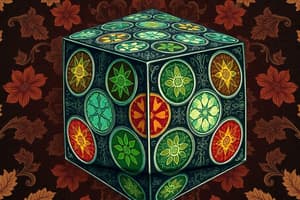Podcast
Questions and Answers
What was the original purpose of the Rubik's Cube when it was invented by Ernő Rubik?
What was the original purpose of the Rubik's Cube when it was invented by Ernő Rubik?
It was created to help explain three-dimensional geometry to his students.
Describe the significance of 1980 in the history of the Rubik's Cube.
Describe the significance of 1980 in the history of the Rubik's Cube.
In 1980, the cube was licensed to the Ideal Toy Corporation and rebranded as the 'Rubik's Cube,' marking its introduction to the Western market.
How did the popularity of the Rubik's Cube change from the mid-1980s to the 2000s?
How did the popularity of the Rubik's Cube change from the mid-1980s to the 2000s?
It saw a decline in interest during the late 1980s but experienced a resurgence in the 2000s due to the rise of speedcubing and social media.
What role does the Rubik's Cube play in education, according to its historical context?
What role does the Rubik's Cube play in education, according to its historical context?
What is notable about the records in speedcubing related to the Rubik's Cube as of 2023?
What is notable about the records in speedcubing related to the Rubik's Cube as of 2023?
Flashcards are hidden until you start studying
Study Notes
History of the Rubik's Cube
-
Invention:
- Created in 1974 by Hungarian architect and professor Ernő Rubik.
- Originally called the "Magic Cube" (Bűvös Kocka) to help explain three-dimensional geometry to his students.
-
First Production:
- In 1975, Rubik patented the cube.
- It was first sold in Hungary in 1977, initially as an educational toy.
-
International Launch:
- In 1980, the cube was licensed to the Ideal Toy Corporation and rebranded as the “Rubik's Cube.”
- It was introduced to the Western market, which led to a rapid rise in popularity.
-
Cultural Phenomenon:
- By the mid-1980s, it became a global craze, selling millions of units worldwide.
- The cube inspired competitions and the creation of solving methods.
-
Decline and Resurgence:
- Interest waned in the late 1980s but saw a resurgence in the 2000s with the rise of speedcubing and social media.
- Newer variants and puzzles have been developed, expanding the brand and its recognition.
-
Current Status:
- The Rubik's Cube remains one of the best-selling puzzles in history, with various competitions held worldwide.
- It has cemented its place in popular culture and has inspired numerous puzzles and spin-offs.
-
World Records:
- Speedcubing has evolved into a competitive sport, with records being regularly updated for solving times.
- The fastest recorded time (as of 2023) for a single solve is under 3 seconds.
-
Educational Use:
- The Rubik's Cube is used in various educational contexts to teach problem-solving, algorithms, and spatial reasoning.
Invention and Naming
- Created in 1974 by Hungarian architect and professor Ernő Rubik.
- Initially called the "Magic Cube" (Bűvös Kocka) by Rubik to help explain three-dimensional geometry to his students.
Production and Branding
- Patented in 1975 by Rubik.
- First sold in Hungary in 1977 as an educational toy.
- Licensed to Ideal Toy Corporation in 1980 and rebranded as the "Rubik's Cube" for the Western market.
Popularity and Influence
- Became a global craze in the mid-1980s, selling millions of units worldwide.
- Inspired competitions and the development of solving methods.
- Experienced a resurgence in the 2000s due to speedcubing and social media.
- Newer variants and puzzles have expanded the brand and its recognition.
Current Status and Legacy
- Remains one of the best-selling puzzles in history.
- Numerous competitions are held worldwide.
- Has cemented its place in popular culture.
- Inspired numerous puzzles and spin-offs.
Speedcubing and Records
- Speedcubing has become a competitive sport with regularly updated solving time records.
- As of 2023, the fastest recorded time for a single solve is under 3 seconds.
Educational Uses
- The Rubik's Cube is used in various educational contexts to teach problem-solving, algorithms, and spatial reasoning.
Studying That Suits You
Use AI to generate personalized quizzes and flashcards to suit your learning preferences.




